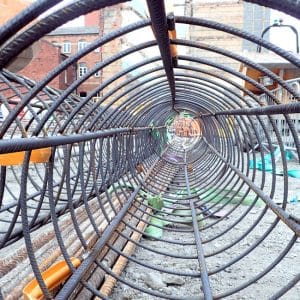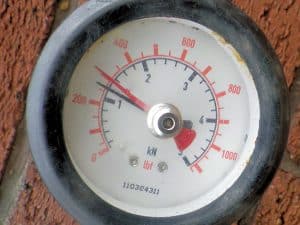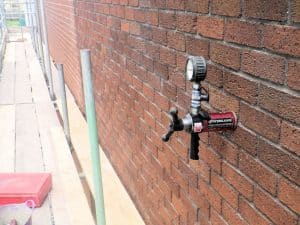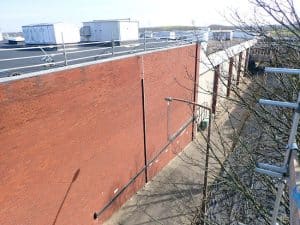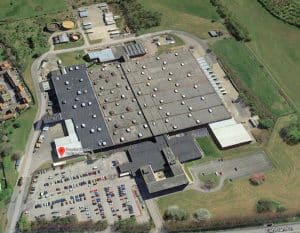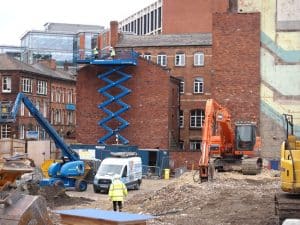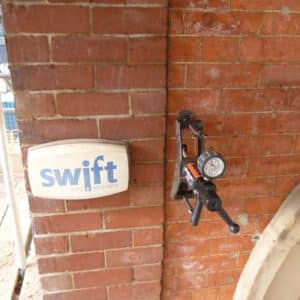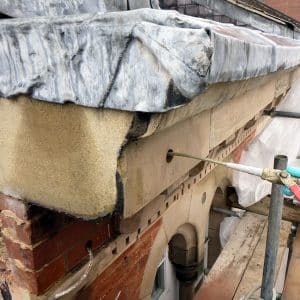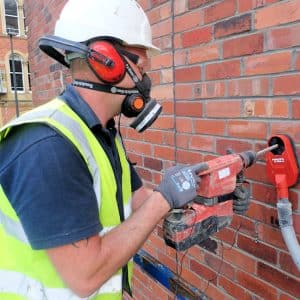What is Wet Rot?
What is Wet Rot?
Any and all wet rot is a fungus, which breaks down wood, causing the wood to decay. Part of the natural ecosystem of the planet, they recycle dead wood, releasing nutrients into the environment in the process. But that’s alright for the forest. read on, for a basic but complete guide on wet rots in the home environment…
To be fair, the title question ought to be – what are wet rots? You see, unlike dry rot, which is a single species of fungus, there are many types of wet rots, which are happy to decay timber in homes. Some are quite easy to diagnose and are very common. On the other hand there are some quite rare species and some attack only one type of timber.
Hardwoods and softwood have their own fungal pathogens and some fungi are not fussy and will attack both.
Also in this section
The chances are that all homeowners will come across wet rot of one kind or another
This may be relatively benign decay in a garden fence post. It could be an attack on your homes essential structural timbers, like floors or roof members.
This is because wet rots are less demanding than dry rot, they can grow and survive in a wider range of conditions. This is the reason why they are common, both in the wild woods of Yorkshire and in its buildings too.
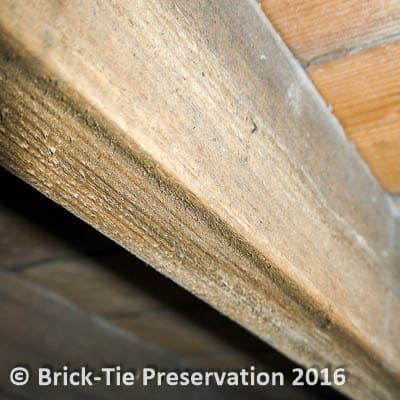
The common denominator for all rots including wet rot, is damp. All of the fungal decay organisms, which can blight homes, evolved from the forest. This means that as far as possible they crave similar conditions to grow and thrive – water is the key.
Before any timber can be prone to attack by any type of wet rot, the wood must be moist. The microscopic spores of these fungi are a natural part of the air we breath. They are in the air everywhere – yes really they are; just like pollen and other particulates. Any air sample, taken from anywhere in the world will contain wet rot and dry rot spores (as well as a host of other spores, both fungal and bacterial). The vast majority of these spores never get to germinate and grow. Settling on a dry floor or roof timber is bad news for a wet rot spore, it will be too dry for it to grow.
Once these spores settle on damp wood, they’ve evolved to wait for a while. Tis is to make sure conditions are stable. Then they germinate and send a tiny tube called a hypha into the wood. Enzymes are secreted and break down the wood and the energy released is used to build a network of fungal strands in the timber – below the surface. If the wood remains damp then it will be consumed and eventually destroyed.
Read on for more information on wet rot; what causes it and how to treat it. Or call us for a friendly chat and for expert advice on Leeds 265 2752, York 566577 or Sheffield 224 5121 or email us via our contact page.
Identifying wet rot
Most wet rot outbreaks in homes rarely display visible fungus, because the activity is usually confined under the surface of the wood. In this regard they are a more efficient wood destroying fungi than dry rot – many wet rots don’t waste precious energy building fungal growths on masonry (though some, notably the Fibroporia species do so). All their effort is spent where it matters, breaking down damp wood from within. This is why for example the wet rot fungus Coniophora puteana will rot the inside of a floor beam away, leaving a sound skin of wood to the naked eye (see fig 1). The wood near the surface of timber is dryer, so this common species of wet rot stays away from that and builds its web of fungal hypha in the damp wood – the wood which it is able to utilise for growth.
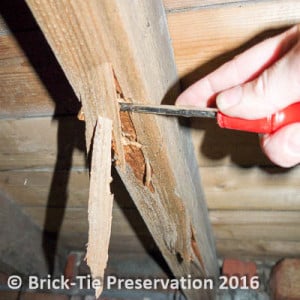
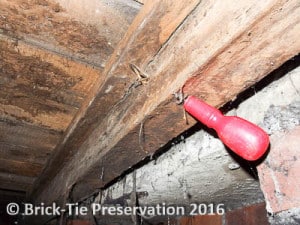
This means that the damage may be considerable, yet only detectable to a trained and experienced timber surveyor (Fig 2). Any building timber with a moisture content over 20% is at risk of attack by wet rot. However, most timber in occupied houses is much dryer than this. If you watch one of our surveyors test skirting boards or door frames in a heated and ventilated house, the readings are often between 8% and 13% – way too dry for wet rot to survive or develop.
Identifying wet attack
We’ve stressed the role of moisture is all rot attacks. The key to avoiding a wet rot outbreak is keeping homes dry and well ventilated. Do this and the spores in the air will never germinate. Your building timbers are safe. There are a few specific and common things, which we find on our damp and timber surveys, which have caused wet rot. We’ve outlined some of the most common things to look out for below, along with the locations, where wet rot attacks.
Wet Rot in floors
The most common cause of wet rot in ground floor timbers and cellars is rising damp, penetrating damp and poor sub-floor or cellar ventilation (fig 3 & 4). In the past, the beams supporting the floors (floor joists) and the associated timber wall plates and lintels were all built into, or resting on naked masonry. If the walls get damp, the timber in them or against them will also become moist. Decay then follows.
- Ground floor timbers will become prone to decay if air bricks are missing, blocked or buried below paths and driveways
- High path levels can bypass your property’s damp course and cause rising damp and penetrating damp at the base of the walls. Lower the paths and have the damp course checked
- Drains and gullies, blocked by leaves or other debris (at the bottom of rainwater down-pipes, or at kitchen waste water grates), are a common cause of rotten floors – clear them now
- Eroded stone, bricks or the pointing between them, can allow rainwater to penetrate at the base of walls and cause wet rot in floors – have a builder repair and re-point or call us.
- Dripping overflow pipes from a toilet cistern don’t just waste water, they can lead to ££££££ of damage due to wet rot in floors – call a plumber.
- Any signs of water damage such as salts at the base of walls (usually seen as white fluffy deposits on plaster or bricks), could mean there is a hidden water source and the risk of wet rots of one sort or another – find the source or ask our surveyors for advice.
- A history of flooding or a pipe burst which may have saturated the sub-floor space or cellar.
There are other causes but the above are common, obvious and easily fixed or avoided.
If these defects are present on a house you are selling or about to buy, we strongly recommend a homebuyers damp and timber survey.
Remember though, that there are other more subtle causes too, like a design of house which is predisposed to ‘dead spots’ of ventilation under the floors
Houses built on boggy ground are at risk; sub-floor humidity, which wet rot craves may be high – even though there are lots of air bricks around. Homes built on flood plains or on steep sided hills are prone too.
A survey by one of our professional specialist surveyors is the best assurance for you. For a small fee you’ll have a qualified and experienced person to give you honest and expert advice. Call us on Leeds 265 2752, York 566577 or Sheffield 224 5121 or email us via our contact page.
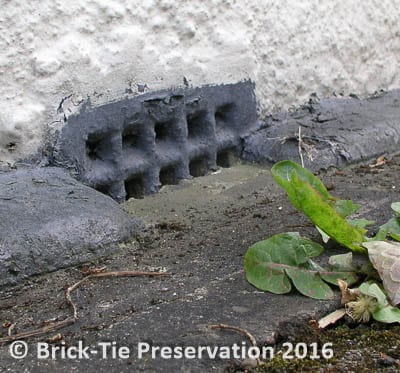
Wet Rot in upper floors and roofs
Severe wet rot in upper floors and roof timbers is less common. This is because whereas the moist conditions under a ground floor can persist for years (when was the last time you looked under your hallway?), water ingress and damp in habitable rooms tends to get noticed and fixed, before serious rot can develop. That said, there are exceptions and we do have to give bad news to homeowners, vendors and buyers when we find wet rot in roof spars, trusses and upper floor timbers. Normally the cause is fairly obvious; leaking roofs and driving rain on exposed gables. However, very old houses with very thick walls may be dry inside and stain free, yet be retaining sufficient water in-depth, to promote wet rot in the ends of large section flooring and roof beams.
See our Historic and heritage building section for details on these buildings. Find below a list of the most common causes of wet rot in upper floors and roofs and ways to avoid problems..
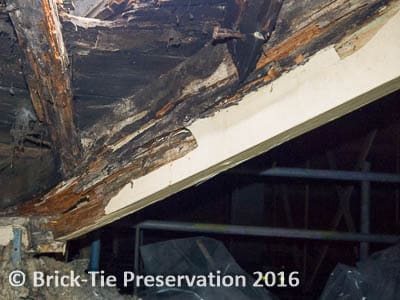
- The eaves areas of roofs are the most at risk – under or behind valley gutters (see fig 5), box gutters and parapet walls – keeping gutters free flowing and well maintained is vital.
- Gables facing westerly will have roof purlins and possibly ceiling joist embedded in them – the end grain of timber is the most absorbent and must be kept dry – maintain the pointing and if you think the masonry or pointing is porous, call us for advice on Deepshield Pro water repellent cream
- Any signs of algae growth, wet stains or salting masonry below gutters or at rainwater down-pipe positions, is an alarm call – keep these clear and repair dripping leaks promptly to avoid wet rot.
- The occasional slipped slate or tile will not cause rot if repaired promptly. Leaving these for long periods or ignoring larger defects is asking for wet rot or dry rot.
- Upper floor bathroom and the central heating system may have overflow pipes protruding from the walls (small plastic pipe). These should never be dripping – if they drip, call a plumber and have the problem fixed.
- Leaks from bathroom and showers etc rarely cause a significant rot problem. This is because the damage to the ceilings below the bath or shower usually raises the alarm before decay develops. Sometimes minor wet rot or localised dry rot can develop if you do not keep the seals around baths and shower trays in good order. However, in cases of a burst pipe, which has saturated timber; after the leak’s repaired it is always important to promote rapid drying. Call our surveyors Paul, Mike or Bryan for advice.
- Defective lead flashing around chimneys and poor chimney pointing or detailing can cause long term water ingress, which may not stain the ceilings. In these cases wet rot can develop in structural trimmers and rafters around the chimney – a roofer should occasionally check for defects and fix them.
The above is not full list of course, but these are the most common causes and we’d rather you escaped a wet rot outbreak.
Want to know a little more about wet rots? Read on to find out about the identification of the different types of wet rot and the ways we treat wet rot. Call our helpful and qualified staff for help.

Need advice or want to book a survey?
Wet Rot – further details
Wet rots can be divided into two basic types: Brown rots and White rots. This is not about colour really, it’s more to do with the way these rots feed from the wood they decay. This page is just a guide, not a science lesson but it’s useful for you to know the basic differences and why there are brown wet rots and white ones. This is important because when looking at wet rots we can tell quite a lot from the colure and texture of the decayed wood.
Brown rots are the most primitive, from a evolutionary point. They have evolved to break down the cellulose and hemicellulose in wood. They cannot break down one of the other key components, which is the lignin.
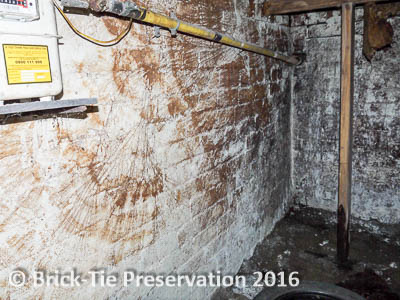
Cellulose gives wood it’s paler colouration and lignin tends to be brown so – remove the pale and leave the brown and we have a brown stained decaying timber. The ‘browning’ effect is more pronounced in some species of rots and the species of timber being decayed. Colour is just one of the features timber surveyors like us use to differentiate between wet rot species.
The thing about cellulose is that it is a ‘long chain molecule’. This, along with hemicellulose, gives wood the tensile strength in the cell walls. Remove or damage the cellulose and the wood becomes brittle – across the grain. So brown rots also tend to cause some form of cuboidal cracking. Taken together these two manifestations of rot narrow down the surveyors options as to which wet rot he’s looking at.
White rots are more efficient in that they have evolved the neat trick of metabolising the cellulose and the lignin. The timber now loses the brown colour associated with lignin, which has been broken down. The cellulose too, has been depleted. This means the timber will lose lots of weight (almost feather light), lots of colour too – becoming very pale if not quite ‘white’. In addition the damage is catastrophic because all strength is lost and the wood is left as a stringy pulp, rather like tobacco. This clever trick is unique to the white rots, which are all wet rots. Remember – there is only one dry rot and it is brown. All this is very useful stuff, for a timber surveyor to know.
Call a Brick-Tie timber expert now for genuine expert advice on Leeds 265 2752, York 566577 or Sheffield 224 5121 or email us via our contact page.
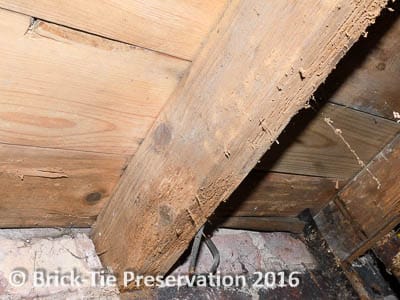
Secondary complications associated with Wet Rot
The forest floor is teeming with life. Once your structural timbers begin to decay, then in some respects they reflect that environment. Other nasty’s are attracted to the decaying wood. Wood boring weevils have evolved to break down decaying wood by feeding on it. There’s no need to drill down into the sub-species of weevils here, however they often occur as a ‘secondary’ pathogen with wet rot. They can considerably worsen the effects of decay, turning wood into a mass of ripped tunnels along the grain, full of sharp fine powder (frass – see fig 6). The good news is that they cannot spread to dry timbers in your home. In effect they are just passengers with the wet rot problem. Once we’ve banished the wet rot and the cause of it, they’ll be gone for good too. It is never necessary to treat a weevil infestation with insecticidal chemicals!
Sometimes wet rot is found with weevil infestation and infestation by other wood boring insects. This could be Common furniture beetle, which can spread through dry timbers and, if not treated will continue to cause damage, even if the source of excess moisture has been dealt with. If treatment for wood borers is required, our qualified surveyors will give you the best advice on safe and effective woodworm treatment.
Sometimes wet rot will decay hidden structural timber, causing cracking and movement in plaster and masonry. These timbers include lintels over door and window heads, roof members, wall plates and multi-section beams over bay windows and larger openings, sometime called bressummers. Where this is severe an engineer is required to investigate. Our engineers are able to specify and action a structural repair.
Preservative Treatment and – avoiding a Wet Rot relapse
Our expert timber surveyors know their rots inside out. Our damp and timber surveys will identify the rot and more importantly, the underlying cause of the problem. Dry wood doesn’t rot. If rot is present in your building timbers there must be a reason for the high moisture levels. We take a holistic approach to timber decay; find the cause and cure that and; you cure the rot for good. In the past there have been cases of builders and less able timber specialist contractors simply treating wet rot by replacing the rotten wood. They may then spray the area with chemical preservatives. This is entirely the wrong approach and is almost always doomed to fail. We still see evidence of this flawed outlook today, though thankfully it is on the decline.
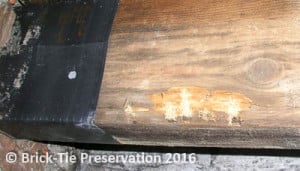
These days, there is much more information freely available on-line. Consumers will often question those who recommend treatment without full diagnosis of the cause. This is why we provide this information; informed consumers are better able to make good choices about who to trust for their wet rot treatment, damp and timber services or indeed any service they need.
The best method of treating wet rot (or dry rot), is to locate the source or sources of excess moisture and rectify these first. Only then can repairs and any essential treatment be applied. To do otherwise is to basically feed the outbreak with more fresh timber, which will just decay because conditions on site are still favourable. It’s a sad but true fact that the quality of the softwood timber these days is lower than that used in earlier times. It tends to be fast grown and if placed in a damp environment, even treatment with a preservative will not hold off rot for long. No – we concentrate on putting right the dampness and then repairing correctly, using methods and treatments to give maximum protection for the timbers as the area dries down. This is why we can confidently offer long term guarantees on our work. Guarantees which have stood the test of time for 30 years.
We do use some chemicals as required. They speed up eradication, kill off insect activity, protect wood if it remains moist for a time. They can give you, a buyer or mortgage lender confidence, that the rot is gone for good. That said, we have families too and we only recommend any chemical treatment after two crucial tests have been past:
- Will the client be worse off if we don’t use a chemical treatment – is application justified technically?
- Have we considered the risk and hazard and can the treatment be done safely for everyone – customer – visitors and our employees?
If we’re recommending preservative treatment for your home, we’ve applied these tests first. A full risk assessment and a detailed safe system of work is prepared for every project no matter how small it may be. Our surveyors are well known in the industry as being at the top of their game. However what about the chaps who apply these chemicals? It is their responsibility to work safely and be diligent and vigilant. This is why our technicians are amongst the best trained and qualified in the whole industry – we know this, we’re Investors In People and we’ve won many awards for training too.
Health and safety? You’re safe with us because we really spend lots of time and effort making sure we do our work in the safest way possible. Our accreditations include CHAS and as PCA members we are audited for our health and safety practice as well as our operational methods. We also employ independent health and safety consultants to inspect us and suggest improvements where they can. This year they were so pleased with our efforts they awarded us a gold standard for health and safety compliance.
Further Reading
There are some further links to our learning resources below if you are still thirsty for knowledge on timber infestations.
Wet Rot Dry Rot White Rot Brown…confused? Don’t be – it’s easy really
A post or two ago I gave some guidance on how to recognise Dry Rot, without sight of Dry Rot’s very specific fruiting body. Since then I’ve been asked to go a little deeper on rots in construction timbers. This post will enable you to quickly tell a white rot from a brown rot. Don’t … Continue reading
Video: This is Timber Decay Caused by White Rot
Why not have a look at our damp and timber Frequently asked question page (FAQ), or the following video is a useful one if you’re not sure how to tell the difference between a brown wet rot and a white rot…



